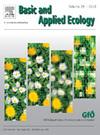Trait-mediated insect colonization of newly established grassland strips in agricultural landscapes
IF 3.5
2区 环境科学与生态学
Q2 ECOLOGY
引用次数: 0
Abstract
Restoring grasslands in agroecosystems through the establishment of grassland and flowering strips has been demonstrated to promote insects. However, the development of the functional composition of insect assemblages in newly established grassland, which determine how species contribute to key ecosystem processes such as pollination, nutrient cycling, and pest control, are less understood. We applied a trait-based approach to investigate the functional insect richness of newly established grassland strips (NG) compared to adjacent permanent, semi-natural “old” grasslands (OG) over a six-year time span in an agricultural landscape in Austria. Specifically, our study focused on identifying species-specific traits that differentiate the assemblages of wild bees, syrphids, butterflies, orthopterans and heteropteran bugs in OG and NG. Our results show that compared to OG, insects in NG were more likely to be more mobile (butterflies, orthopterans, heteropteran bugs), less likely to be zoophagous (syrphids, orthopterans, heteropteran bugs), less likely to be feeding specialized (wild bees, orthopterans, heteropteran bugs) and less likely to be wood associated (butterflies). Investigating the temporal development of traits, our study reveals a shift in the abundance of zoophagous syrphids and mobile orthopterans following the establishment of NG: while we found lower numbers of zoophagous syrphids and mobile orthopterans in the first three years after the establishment of NG, this was no longer the case after five years.
Our study suggests that although plant-diverse new grassland strips may exhibit equal taxonomic richness as permanent grasslands if created near the latter, they promote different functional compositions, even six years after establishment. Due to the lower initial occurrence of zoophagous insects following grassland establishment compared to permanent grassland, benefits for pest control could be delayed.
农业景观中新草地带昆虫定殖的性状介导
通过建立草地和花带来恢复农业生态系统中的草地已被证明可以促进昆虫的生长。然而,在新建立的草地中,昆虫组合的功能组成的发展,决定了物种如何对关键的生态系统过程(如授粉、养分循环和害虫控制)做出贡献,却知之甚少。本文采用基于性状的方法,对奥地利农业景观中新建草地带(NG)与相邻的永久性、半自然“旧”草地(OG)在6年时间跨度内的昆虫功能丰富度进行了比较研究。具体来说,我们的研究重点是识别野生蜜蜂、蚜虫、蝴蝶、直翅目和异翅目昆虫在OG和NG中组合的物种特异性特征。我们的研究结果表明,与OG相比,NG中的昆虫更有可能更具流动性(蝴蝶,直翅目,异翅目昆虫),不太可能是食虫的(蚜虫,直翅目,异翅目昆虫),不太可能是专门喂养的(野蜂,直翅目,异翅目昆虫),不太可能是木材相关的(蝴蝶)。在研究性状的时间发展时,我们的研究揭示了动物食蚜虫和活动矫形动物的丰度在动物食蚜虫建立后发生了变化:虽然我们发现动物食蚜虫和活动矫形动物的数量在动物食蚜虫建立后的前三年有所减少,但在五年后情况不再如此。我们的研究表明,虽然植物多样性的新草地带可能与永久草地具有相同的分类丰富度,但即使在建立六年之后,它们也会促进不同的功能组成。由于与永久草地相比,建立草地后食虫的初始发生率较低,因此可能会延迟害虫防治的效益。
本文章由计算机程序翻译,如有差异,请以英文原文为准。
求助全文
约1分钟内获得全文
求助全文
来源期刊

Basic and Applied Ecology
环境科学-生态学
CiteScore
6.90
自引率
5.30%
发文量
103
审稿时长
10.6 weeks
期刊介绍:
Basic and Applied Ecology provides a forum in which significant advances and ideas can be rapidly communicated to a wide audience. Basic and Applied Ecology publishes original contributions, perspectives and reviews from all areas of basic and applied ecology. Ecologists from all countries are invited to publish ecological research of international interest in its pages. There is no bias with regard to taxon or geographical area.
 求助内容:
求助内容: 应助结果提醒方式:
应助结果提醒方式:


